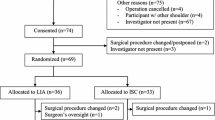Abstract
Purpose
In the present study, we evaluated the effects of interscalene brachial plexus block on postoperative pain relief and morphine consumption after modified radical mastectomy (MRM).
Methods
Sixty ASA I–III patients scheduled for elective unilateral MRM under general anesthesia were included. They were randomly allocated into two groups: group 1 (n = 30), single-injection ipsilateral interscalene brachial plexus block; group 2 (n = 30), control group. Postoperative analgesia was provided with IV PCA morphine during 24 h postoperatively. Pain intensity was assessed with the visual analogue scale (VAS). Morphine consumption, side effects of opioid, antiemetic requirement, and complications associated with interscalene block were recorded.
Results
VAS scores were significantly lower in group 1, except in the first postoperative 24 h (p < 0.007). The patients without block consumed more morphine [group 1, 5 (0–40) mg; group 2, 22 (6–48) mg; p = 0.001]. Rescue morphine requirements were also higher in the postoperative first hour in group 2 (p = 0.001). Nausea and antiemetic requirements were significantly higher in group 2 (p = 0.03 and 0.018). Urinary retention was observed in 1 patient in group 2 and signs of Horner’s syndrome in 2 patients in group 1.
Conclusions
The optimal method has not been defined yet for acute pain palliation after MRM. Our study demonstrated that the use of interscalene block in patients undergoing MRM improved pain scores and reduced morphine consumption during the first 24 h postoperatively. The block can be a good alternative to other invasive regional block techniques used for postoperative pain management after MRM.

Similar content being viewed by others
References
Bland KI, Vezedis MP, Copeland III EM. Breast. In: Schwartz SI, editor. Principles of surgery. 7th ed. New York: McGraw-Hill; 1999. p. 576–9.
Fecho K, Miller NR, Merritt SA, Klauber-Demore N, Hultman CS, Blau WS. Acute and persistent postoperative pain after breast surgery. Pain Med. 2009;10(4):708–15.
Chang SH, Mehta V, Langford RM. Acute and chronic pain following breast surgery. Acute Pain. 2009;11(1):1–14.
Boughey JC, Goravanchi F, Parris RN, Kee SS, Kowalski AM, Frenzel JC, Bedrosian I, Meric-Bernstam F, Hunt KK, Ames FC, Kuerer HM, Lucci A. Prospective randomized trial of paravertebral block for patients undergoing breast cancer surgery. Am J Surg. 2009;198(5):720–5.
Doss NW, Ipe J, Crimi T, Rajpal S, Cohen S, Fogler RJ, Michael R, Gintautas J. Continuous thoracic epidural anesthesia with 0.2% ropivacaine versus general anesthesia for perioperative management of modified radical mastectomy. Anesth Analg. 2001;92(6):1552–7.
Oakley N, Dennison A, Shorthouse A. A prospective audit of simple mastectomy under local anesthesia. Eur J Surg Oncol. 1996;22(2):134–6.
Stein HD. Ambulatory breast biopsies: the patient’s choice. Am Surg. 1982;48(5):221–4.
Huang T, Parks DH, Lewis SR. Outpatient breast surgery under intercostal block anesthesia. Plast Reconstr Surg. 1979;63(3):299–303.
Fassoulaki A. Brachial plexus block for pain relief after modified radical mastectomy. Anesth Analg. 1982;61(12):986–7.
Lynch EP, Welch KJ, Carabuena JM, Eberlein TJ. Thoracic epidural anesthesia improves outcome after breast surgery. Ann Surg. 1995;222(5):663–9.
Coveney E, Weltz CR, Greengrass R, Iglehart JD, Leight GS, Steele SM, Lyerly HK. Use of paravertebral block anesthesia in the surgical management of breast cancer: experience in 156 cases. Ann Surg. 1998;227(4):496–501.
Sundarathiti P, Pasutharnchat K, Kongdan Y, Suranutkarin PE. Thoracic epidural anesthesia (TEA) with 0.2% ropivacaine in combination with ipsilateral brachial plexus block (BPB) for modified radical mastectomy (MRM). J Med Assoc Thai. 2005;88(4):513–20.
Macéa JR, Freganani JHTG. Anatomy of the thoracic wall, axilla and breast. Int J Morphol. 2006;24(4):691–704.
Bland KI, Copeland III EM. The breast: comprehensive management of benign and malignant diseases. 2nd ed. Philadelphia: Saunders; 1998. p. 9–36.
Assa J. The intercostobrachial nerve in radical mastectomy. J Surg Oncol. 1974;6(2):123–6.
Klein SM, Evans H, Nielsen KC, Tucker MS, Warner DS, Steele SM. Peripheral nerve block techniques for ambulatory surgery. Anesth Analg. 2005;101:1663–76.
Sripada R, Bowens C Jr. Regional anesthesia procedures for shoulder and upper arm surgery upper extremity update—2005 to present. Int Anesthesiol Clin. 2012;50(1):26–46.
Chan VW, Perlas A, McCartney CJ, Brull R, Xu D, Abbas S. Ultrasound guidance improves success rate of axillary brachial plexus block. Can J Anaesth. 2007;54:176–82.
Falcão LF, Perez MV, de Castro I, Yamashita AM, Tardelli MA, Amaral JL. Minimum effective volume of 0.5% bupivacaine with epinephrine in ultrasound-guided interscalene brachial plexus block. Br J Anaesth. 2012;110(3):450–5.
Neal JM, Brull R, Chan VW, Grant SA, Horn JL, Liu SS, McCartney CJ, Narouze SN, Perlas A, Salinas FV, Sites BD, Tsui BC. The ASRA evidence-based medicine assessment of ultrasound-guided regional anesthesia and pain medicine: executive summary. Reg Anesth Pain Med. 2010;35(2):1–9.
Carpenter JS, Andrykowski MA, Sloan P, Cunningham L, Cordova MJ, Studts JL, McGrath PC, Sloan D, Kenady DE. Postmastectomy/postlumpectomy pain in breast cancer survivors. J Clin Epidemiol. 1998;51(12):1285–92.
Wallace AM, Wallace MS. Postmastectomy and postthoracotomy pain. Anesthesiol Clin N Am. 1997;15(2):353–70.
Poleshuck EL, Katz J, Andrus CH, Hogan LA, Jung BF, Kulick DI, Dworkin RH. Risk factors for chronic pain following breast cancer surgery: a prospective study. J Pain. 2006;7(9):626–34.
Katz J, Poleshuck EL, Andrus CH, Hogan LA, Jung BF, Kulick DI, Dworkin RH. Risk factor for acute pain and its persistence following breast cancer surgery. Pain. 2005;119(1–3):16–25.
Vecht CJ, Van de Brand HJ, Wajer OJ. Post-axillary dissection pain in breast cancer due to a lesion of the intercostobrachial nerve. Pain. 1989;38(2):171–6.
Kehlet H. Perioperative analgesia to prevent chronic postmastectomy pain. Anesth Analg. 2006;103(2):494.
Boughey JC, Goravanchi F, Parris RN, Kee SS, Frenzel JC, Hunt KK, Ames FC, Kuerer HM, Lucci A. Improved postoperative pain control using thoracic paravertebral block for breast operations. Breast J. 2009;15(5):483–8.
Conflict of interest
None.
Author information
Authors and Affiliations
Corresponding author
About this article
Cite this article
Kaya, M., Oğuz, G., Şenel, G. et al. Postoperative analgesia after modified radical mastectomy: the efficacy of interscalene brachial plexus block. J Anesth 27, 862–867 (2013). https://doi.org/10.1007/s00540-013-1647-z
Received:
Accepted:
Published:
Issue Date:
DOI: https://doi.org/10.1007/s00540-013-1647-z




